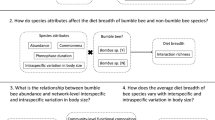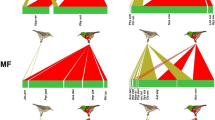Abstract
In group-living animals, an individual’s fitness is predicted by non-random interactions with other group members and social network analysis has become a powerful tool to study these interactions. We experimentally studied the social network structure in group-foraging subsocial spiders that naturally live in kin groups but accept immigrants. Spiderlings were individually marked and we observed interactions during six foraging trials in groups comprising (i) siblings, (ii) siblings with two non-siblings, and (iii) assorted spiderlings. In this foraging context, we found a higher social network structure in sibling groups compared with assorted groups or sibling groups containing two non-siblings. We asked whether non-siblings in the treatment containing mostly siblings and two immigrants are excluded or less connected, which would explain the overall reduced social network structure of the whole group. We found that non-siblings were not generally excluded but that their presence negatively affected the network structure of the whole group. The connectivity of foreign individuals in this treatment was moreover predicted by their size relative to the other group members with very small and very large spiderlings being well connected. Our findings support the idea that siblings have an advantage over unrelated individuals and that the social network structure may play a role in the evolution of social behaviour in spiders.


Similar content being viewed by others
References
Amir N, Whitehouse MEA, Lubin Y (2000) Food consumption rates and competition in a communally feeding social spider, Stegodyphus dumicola (Eresidae). J Arachnol 28:195–200
Avilés L (1997) Causes and consequences of cooperation and permanent-sociality in spiders. In: Choe JC, Crespi BJ (eds) The evolution of social behavior in insects and arachnids. Cambridge University Press, Cambridge, Massachusetts, pp 476–498
Brown JL (1983) Cooperation—a biologist's dilemma. In: Rosenblatt J (ed) Advances in the study of behavior. Academic Press, pp 1-37
Cameron EZ, Setsaas TH, Linklater WL (2009) Social bonds between unrelated females increase reproductive success in feral horses. Proc Natl Acad Sci U S A 106:13850–13853
Choe JC, Crespi BJ (1997) Explanation and evolution of social systems. In: Choe JC, Crespi BJ (eds) The evolution of social behaviour in Insects and Arachnids. Cambridge University Press, Cambridge, Massachusetts, pp 499–524
Croft DP, Hamilton PB, Darden SK, Jacoby DMP, James R, Bettaney EM, Tyler CR (2012) The role of relatedness in structuring the social network of a wild guppy population. Oecologia 170:955–963
Croft DP, Krause J, Darden SK, Ramnarine IW, Faria JJ, James R (2009) Behavioural trait assortment in a social network: patterns and implications. Behav Ecol Sociobiol 63:1495–1503
Croft DP, Krause J, James R (2004) Social networks in the guppy (Poecilia reticulata). Proc R Soc B 271:S516–S519
Émlen ST (1982) The evolution of helping: an ecological constraints model. Am Nat 119:29–39
Evans TA (1998a) Factors influencing the evolution of social behaviour in Australian crab spiders (Araneae: Thomisidae). Biol J Linn Soc 63:205–219
Evans TA (1998b) Offspring recognition by mother crab spiders with extreme maternal care. Proc R Soc B 265:129–134
Evans TA (1999) Kin recognition in a social spider. Proc R Soc B 266:287–292
Evans TA, Goodisman MAD (2002) Nestmate relatedness and population genetic structure of the Australian social crab spider Diaea ergandros (Araneae: Thomisidae). Mol Ecol 11:2307–2316
Fewell JH (2003) Social insect networks. Science 301:1867–1870
González-Tokman D, Ruch J, Pulpitel T, Ponton F (2014) Cuticular antifungals in spiders: density- and condition dependence. Plos One 9:e91785
Hamilton WD (1964) The genetical evolution of social behaviour I & II. J Theor Biol 7:1–52
Hardin G (1968) The tragedy of the commons. Science 162:1243–1248
Kerth G, Perony N, Schweitzer F (2011) Bats are able to maintain long-term social relationships despite the high fission–fusion dynamics of their groups. Proc R Soc B
Krause J, Croft DP, James R (2007) Social network theory in the behavioural sciences: potential applications. Behav Ecol Sociobiol 62:15–27
Krause J, James R, Croft DP (2010) Personality in the context of social networks. Philos Trans R Soc B 365:4099–4106
Kurvers R, Adamczyk V, Kraus RHS, Hoffman JI, van Wieren SE, van der Jeugd HP, Amos W, Prins HHT, Jonker RM (2013) Contrasting context dependence of familiarity and kinship in animal social networks. Anim Behav 86:993–1001
Kurvers RHJM, Krause J, Croft DP, Wilson ADM, Wolf M (2014) The evolutionary and ecological consequences of animal social networks: emerging issues. Trends Ecol Evol 29:326–335
Lengyel S (2007) Benefits of large broods by higher chick survival and better territories in a precocial shorebird. Behav Ecol Sociobiol 61:589–598
Lion S, van Baalen M (2008) Self-structuring in spatial evolutionary ecology. Ecol Lett 11:277–295
Lubin Y, Bilde T (2007) The evolution of sociality in spiders. Adv Stud Behav 37:83–145
Lusseau D, Newman MEJ (2004) Identifying the role that animals play in their social networks. Proc R Soc B 271:S477–S481
Marcoux M, Lusseau D (2013) Network modularity promotes cooperation. J Theor Biol 324:103–108
Morrell LJ, Croft DP, Dyer JRG, Chapman BB, Kelley JL, Laland KN, Krause J (2008) Association patterns and foraging behaviour in natural and artificial guppy shoals. Anim Behav 76:855–864
Naug D (2009) Structure and resilience of the social network in an insect colony as a function of colony size. Behav Ecol Sociobiol 63:1023–1028
Pike TW, Samanta M, Lindstrom J, Royle NJ (2008) Behavioural phenotype affects social interactions in an animal network. Proc R Soc B 275:2515–2520
Pruitt JN, Riechert SE (2009) Frequency-dependent success of cheaters during foraging bouts might limit thier spread within colonies of a socially polymorphic spider. Evolution 63:2966–2973
Pruitt JN, Riechert SE (2011) How within-group behavioural variation and task efficiency enhance fitness in a social group. Proc R Soc B 278:1209–1215
Royle NJ, Pike TW, Heeb P, Richner H, Kolliker M (2012) Offspring social network structure predicts fitness in families. Proc R Soc B 279:4914–4922
Ruch J, Heinrich L, Bilde T, Schneider JM (2009) Relatedness facilitates cooperation in the subsocial spider, Stegodyphus tentoriicola. BMC Evol Biol 9
Ruch J, Herberstein ME, Schneider JM (2014a) Families hunt more successfully: effect of group composition on hunting and communal feeding. Anim Behav 91:170–177
Ruch J, Herberstein ME, Schneider JM (2014b) Offspring dynamics affect food provisioning, growth and mortality in a brood-caring spider. Proc R Soc B 281
Schneider JM (1996) Differential mortality and relative maternal investment in different life stages in Stegodyphus lineatus (Araneae, Eresidae). J Arachnol 24:148–154
Schneider JM, Bilde T (2008) Benefits of cooperation with genetic kin in a subsocial spider. Proc Natl Acad Sci U S A 105:10843–10846
Silk JB (2007) Social components of fitness in primate groups. Science 317:1347–1351
Silk JB, Beehner JC, Bergman TJ, Crockford C, Engh AL, Moscovice LR, Wittig RM, Seyfarth RM, Cheney DL (2009) The benefits of social capital: close social bonds among female baboons enhance offspring survival. Proc R Soc B 276:3099–3104
Silk JB, Beehner JC, Bergman TJ, Crockford C, Engh AL, Moscovice LR, Wittig RM, Seyfarth RM, Cheney DL (2010) Strong and consistent social bonds enhance the longevity of female baboons. Curr Biol 20:1359–1361
Szymkowiak P (2014) Revision of Australian species of the genus Diaea (Araneae: Thomisidae) with redefinition of their taxonomic status. Ann Zool 64:333–477
Unglaub B, Ruch J, Herberstein ME, Schneider JM (2013) Hunted hunters? Effect of group size on predation risk and growth in the Australian subsocial crab spider Diaea ergandros. Behav Ecol Sociobiol 67:785–794
Whitehouse MEA, Lubin Y (1999) Competitive foraging in the social spider Stegodyphus dumicola. Anim Behav 58:677–688
Yip EC, Rayor LS (2014) Maternal care and subsocial behaviour in spiders. Biol Rev 89:427–449
Acknowledgments
We would like to thank Gerald Kerth, Mark Elgar, and an anonymous reviewer for helpful comments on the manuscript. JR was funded by an international scholarship of Macquarie University.
Author information
Authors and Affiliations
Corresponding author
Additional information
Communicated by M. Elgar
Rights and permissions
About this article
Cite this article
Ruch, J., Dumke, M. & Schneider, J.M. Social network structure in group-feeding spiders. Behav Ecol Sociobiol 69, 1429–1436 (2015). https://doi.org/10.1007/s00265-015-1955-4
Received:
Revised:
Accepted:
Published:
Issue Date:
DOI: https://doi.org/10.1007/s00265-015-1955-4




